Safari Overview
Marangu is the only route which offers sleeping huts in dormitory style accommodations. There are 60 bunk beds each at Mandara and Kibo Huts, and 120 bunk beds at Horombo Hut.
Guests are supplied with mattresses and pillows, but sleeping bags are still required. The huts have communal dining halls and basic washrooms, ranging from flushing toilets and running water at the lower huts to long drop toilets and buckets of water at Kibo Hut. Also available for consumption are soft drinks, bottled water, and beer.
On the 6-day Marangu route, an extra day is added on the 5-days route to help with acclimatization. This extra day is very crucial, apart from that, the route is the same.
The extra day can be spent resting at Horombo or climbing the small peak of Mawenzi.

Safari Itinerary
Day 1 – MANDARA HUT
This morning you drive (about 3 hours) through Kilimanjaro semi-tropical foothills to Marangu (1,372m), situated on the south-eastern side of the mountain. As you drive, there are usually some excellent views of the snow-capped peak. On arrival at Marangu gate, you meet your team of guides and porters, pick up any last minute supplies for the trek, and head to the entrance of Mount Kilimanjaro National Park to register for the climb. From the cluster of buildings at the gate it is some four to five hours walk through patches of coffee plantation and dense rainforest to Mandara Hut. The forest teems with brightly-coloured bird life, colobus and other varieties of monkey. The flora includes numerous mosses, lichens and flowers, as well as delicate orchids. If the skies are clear you may have fine views over the town of Moshi lying at the edge of the plain far below.
Mandara Hut is a collection of basic, A-frame mountain huts with bunk beds – quite adequate for your needs – where you inevitably meet up with fellow trekkers who are bent on the same goal. Overnight stay Mandara Hut
Day 2 – HOROMBO HUT (3,720m)
Your second day on the mountain starts with a steep climb through the last swathe of rainforest, though this soon gives way to rolling alpine meadow dotted with giant heather. Once you leave the forest canopy, Kilimanjaro’s twin peaks – snowcoveredKibo and rocky Mawenzi – lie directly ahead, dominating the skyline. Further on you cross a zone of open heath with stunted vegetation, before emerging onto bleak moorland. Today you gain roughly 1,000m in altitude, and your walk can take anything from five to seven hours – depending on your pace. Tonight you stay at Horombo Huts – another collection of buildings similar in style to those at Mandara – which offer shelter and basic accommodation to those on the mountain.
Overnight stay at Horombo Hut
Day 3 – HOROMBO HUT
A day here provides an opportunity for you to acclimatise gradually to the altitude. Statistics show that an acclimatisation day like this effectively doubles the chance of making it to the summit, so this time is well spent! The day is not exactly wasted as there are a few walks you can make in the vicinity of the hut – the most popular of which is to the base of Mawenzi Peak, the dramatic eastern summit of Kili. This walk takes four to five hours (round trip), and will get you to an altitude of 4,600m before you return to the hut – this will stand you in good stead later on.Overnight stay at Horombo Hut
Day 4 – KIBO HUT (4,705m)
The landscape becomes progressively more rocky and rugged as you leave the ?everlasting flowers? and other bizarre alpine plants behind. Giant groundsels and lobelias appear in the sparse moorland. Today’s trail up to Kibo will again take anything between five and seven hours. Skirting Mawenzi Peak, you pass Last Water then cross a stark, almost lunar landscape onto “The Saddle”, a broad tundra desert between the two peaks of Mawenzi and Kibo. From here you start to get fantastic views of the upper reaches of the mountain before arriving at Kibo Hut (4,705m), a dry-stone-walled hut with dormitories and limited facilities. Tonight you prepare for tomorrow’s final assault – THE SUMMIT – re-packing to leave any non-essential items with the porters; you need to summon all your energy to get to the summit so there’s absolutely no point in carrying anything you don’t need! An early night is imperative as you must make a midnight start in order to reach the summit in the morning before the cloud cover settles, and then have time to get back down to the hut. Overnight stay at Kibo Hut
Day 5 – UHURU PEAK (5,896m)
This is a long and demanding day! The guides wake you soon after midnight and you start out in darkness, zigzagging up a long scree slope by the light of your torch in the extreme cold. At this time of day the scree is still frozen – which makes it easier to walk on! After roughly two hours you should reach Hans Meyer’s Cave – named after the German geologist who made the first successful ascent in 1889 – where he found the remains of a frozen leopard. The gradient gets steeper and three hours on (this is the hardest stretch of the ascent!) you should reach the crater rim at Johanne?s Notch. From here it’s a short scramble to Gillman’s Point (5,685m) in time for dawn. Your reward is the dramatic spectacle of the sun rising over the ice fields and craggy peaks of Mawenzi – the profusion of colors and shapes make all the suffering seem worthwhile! For those who still have the energy and drive, it takes another couple of hours along the crater rim to reach Uhuru (Freedom) Peak (5,896m). Your descent (approx 3 hours) retraces the route back down past Kibo Hut to Horombo Hut for a well-deserved rest.
Overnight stay at Horombo Hut for 1 night (Breakfast, Lunch and Dinner)
Day 6 – Back to ARUSHA.
The pace quickens as you continue your triumphant way back down across alpine meadow and past Mandara Hut through the rainforest to Marangu Gate where you board the vehicle for the journey back to Arusha. Breakfast and Lunch are included in this day.
End of Tour
Tour Includes
- Overnight stays in mountain Huts
- Professional, experienced, mountain guides:
- Mountain Equipment, Sleeping tents, Kitchen tents, Porters, Guides and Chef
- Tents, Table and Chairs, Food utensils and so on.
- All Park fees
- Rescue fees
- All meals while on the Mountain
- Guides, Porters, cook salaries and park fees
- Quality Mess tents with table and chairs
- Large portions of fresh, healthy nutritious food
- Clean, purified drinking water
- Crisis management and safety procedures
- Fair and ethical treatment of porters
Tour Excludes
- Airport transfers
- Accommodation in Arusha
- Tanzania Visa
- Gratuity
- Personal Expenses (e.g. laundry, telephone, beverages, etc.)
- Meals not listed above
- Optional Tours (short safari after your climb etc)

